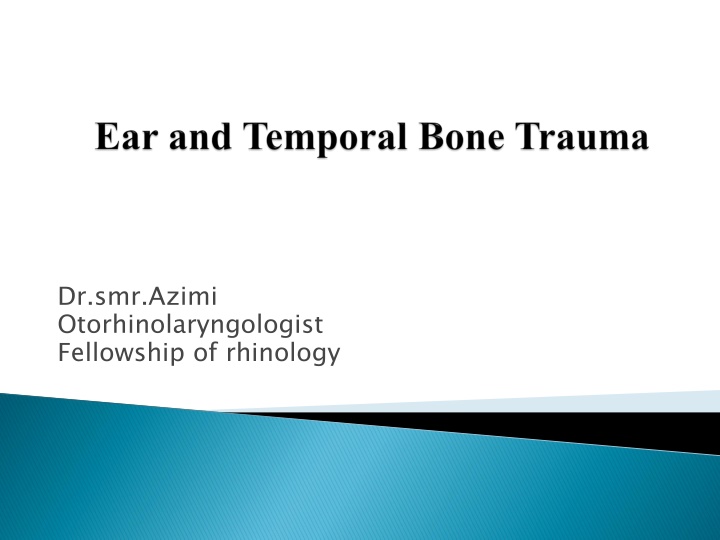
Understanding Temporal Bone Fractures and Their Causes
Learn about temporal bone fractures, their causes such as motor vehicle accidents and assault, and associated symptoms like auricular pain, hearing loss, and facial nerve injury. Discover the types of fractures, diagnostic features, and management options for these traumatic injuries in the head and neck region.
Download Presentation

Please find below an Image/Link to download the presentation.
The content on the website is provided AS IS for your information and personal use only. It may not be sold, licensed, or shared on other websites without obtaining consent from the author. If you encounter any issues during the download, it is possible that the publisher has removed the file from their server.
You are allowed to download the files provided on this website for personal or commercial use, subject to the condition that they are used lawfully. All files are the property of their respective owners.
The content on the website is provided AS IS for your information and personal use only. It may not be sold, licensed, or shared on other websites without obtaining consent from the author.
E N D
Presentation Transcript
Dr.smr.Azimi Otorhinolaryngologist Fellowship of rhinology
The most common cause of temporal bone fractures is motor vehicle accidents. Assault is the second most common cause
Blunt injury: auricular pain, edema, erythema, and hematoma Burn injuries: blistering, skin de-epithelialization, and cartilage exposure frostbite injury: over several weeks, from clear blistering, hemorrhagic blisters, or a dry insensate wound to blackened tissue demarcation and necrosis.
EAC trauma and traumatic tympanic membrane perforations: pain, bloody otorrhea, and conductive hearing loss middle ear trauma: hemotympanum (blood in the middle ear) osicular risruption conductive hearing loss 1. 2. 3. Trauma involving the inner ear: sensorineural hearing loss (e.g., cochlear concussion, otic capsule violating fracture) vertigo ( benign paroxysmal positional vertigo, labyrinthine concussion, perilymphatic fistula, vestibular loss) 1. 2.
Facial nerve injury 1. immediate 2. Delayed leakage of cerebrospinal fluid (CSF) blunt trauma in middle cranial fossa plate, posterior cranial fossa plate, or otic capsule clear middle ear effusion otorrhea, or rhinorrhea life-threatening hemorrhage and hemodynamic instability horizontal and vertical petrous internal carotid artery sigmoid sinus jugular bulb
otorrhea, hearing loss, nystagmus, and facial paralysis Battle sign: A bruise over the mastoid fracture of the middle cranial fossa and injury of the posterior auricular artery raccoon eyes : Periorbital ecchymosis basal skull fracture
Temporal bone fractures 1. otic-sparing 2. otic-violating (rupture) longitudinal fracture (oriented along the petrous axis, parallel to the petrotympanic fissure) transverse fracture (oriented perpendicular to the petrous axis) oblique (oriented along the petrous axis, crossing the petrotympanic fissure) mixed fractures 1. 2. 3. 4.
Oblique/longitudinal fractures 80% of all temporal bone fractures 25% associated with facial nerve injury Transverse fractures 40 to 50% are associated with facial palsy more commonly affect the otic capsule and cause sensorineural hearing loss
Physical Exam Imaging High-resolution computed tomography (CT) Angiography PTA ENoG, EMG
Ear canal injuries traumatic tympanic membrane perforations perilymphatic fistula
